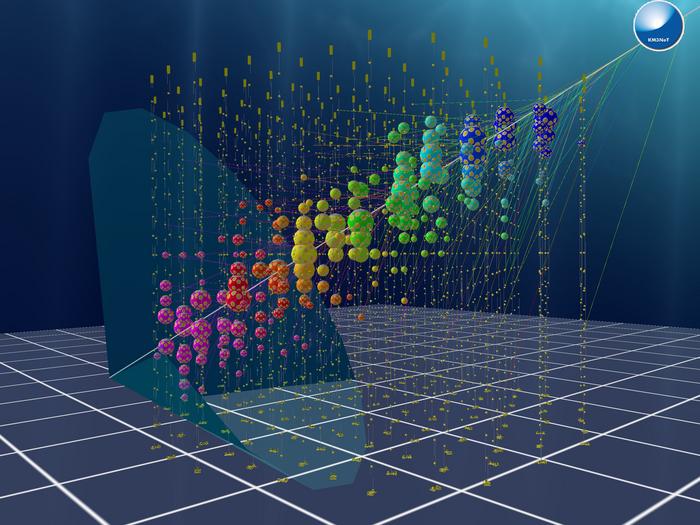Quantum gravity represents an elusive frontier in modern physics, sitting at the intersection of general relativity and quantum mechanics. The quest for a coherent theory that explains the vast cosmos alongside the subatomic realm continues to drive scientific inquiry, with many researchers believing that neutrinos—those enigmatic, nearly massless particles—might hold the key. These elusive particles, which interact only very weakly with matter, tend to slip through the universe unnoticed. Nevertheless, they may provide vital clues to the mysteries of quantum gravity.
Detecting neutrinos remains a formidable challenge, largely due to their remarkable ability to traverse matter almost without a trace. However, in rare instances, a neutrino can interact with matter, such as when it encounters water molecules in the depths of the ocean. This interaction generates a distinctive blue glow known as Čerenkov radiation, a phenomenon that can be captured by specialized detection instruments like the KM3NeT (Kilometer Cube Neutrino Telescope). This observatory, situated on the seabed off the coast of Toulon, France, represents a significant step forward in our ability to study these elusive particles.
The KM3NeT is specifically designed to capture and analyze neutrinos through their interactions in the deep sea. Its architecture includes various detectors, with the ORCA (Oscillation Research with Cosmics in the Abyss) specifically focusing on measuring neutrino oscillations. At a staggering depth of approximately 2,450 meters, ORCA offers a unique vantage point for observing neutrinos as they traverse the Mediterranean waters.
Merely detecting neutrinos is insufficient for drawing comprehensive conclusions about the nature of quantum gravity. A significant aspect of this research involves the concept of decoherence. As neutrinos journey through space, they oscillate and change their “flavor,” a term used by scientists to describe their varying identities. This oscillation is inherently linked to coherence—the degree to which a neutrino exists in a quantum state mixture. Without coherence, the expected oscillations become unpredictable, raising intriguing questions about the role of quantum gravity and the nature of these oscillations.
Theoretical models of quantum gravity suggest that neutrinos are not isolated entities but may interact with their surroundings, leading to potential decoherence. This interaction could decrease the predictability of their oscillations, affecting both the detected signals and our understanding of fundamental physics. According to Nadja Lessing, a physicist at the Instituto de Física Corpuscular, decoherence could serve as an important signal in the search for quantum gravity effects.
In a comprehensive study conducted by Lessing and her team, data from the KM3NeT/ORCA were meticulously analyzed to search for evidence of decoherence affecting neutrino oscillations. An intriguing finding emerged: the neutrinos studied exhibited no signs of decoherence, suggesting that if quantum gravity impacts neutrino oscillations, it does so at a level below current observational limits. This result offers fresh insights into the nuances of quantum gravity, helping to establish upper limits for the strength of its influence on neutrino behavior.
The implications of this research are profound, enhancing our understanding of fundamental physics and the search for a unified theory. According to Lessing, the absence of detected decoherence indicates that future investigations may still uncover vital information regarding the interactions of neutrinos in the cosmos. This study not only contributes to our knowledge of neutrinos but also guides future research directions, as scientists seek to push the boundaries of what is currently known.
Finding clear evidence for neutrino decoherence would mark a groundbreaking advancement in the field, especially given that current theoretical frameworks have yet to offer direct evidence of quantum gravity. The growing interest in this phenomenon suggests a rich landscape for exploration, where researchers are motivated to delve deeper into the unknown. The questions posed by neutrino studies resonate strongly with foundational principles of quantum mechanics, making them particularly tantalizing in the context of enhancing our understanding of the universe.
The scientific community is keenly aware that uncovering the secrets of quantum gravity could yield transformative insights into the universe’s underlying fabric. By employing advanced instruments like the KM3NeT, physicists are equipped to gather data on neutrinos and probe deeper into the mysteries of the cosmos. As the search for evidence of quantum gravity continues, neutrino experiments will take center stage, advancing our efforts in this complex arena.
In conclusion, the exploration of neutrino behavior and the search for quantum decoherence remain at the forefront of modern physics. The results from the now-concluded study conducted by Lessing and her colleagues hint at the nuanced relationship between quantum gravity and neutrinos. As scientists harness the potential of advanced detection technologies like the KM3NeT, they remain dedicated to unveiling the cosmic drama that unfolds at the intersection of the infinitely large and the infinitesimally small. This journey into the heart of quantum phenomena promises to reshape our understanding of the universe.
Subject of Research: Quantum Decoherence in Neutrino Oscillations
Article Title: Search for Quantum Decoherence in Neutrino Oscillations with Six Detection Units of KM3NeT/ORCA
News Publication Date: 20-Mar-2025
Web References: Not provided
References: Not provided
Image Credits: CC BY-NC 4.0, Credits KM3NeT
Keywords
quantum gravity, quantum decoherence, experimental physics, cosmic neutrinos, particle physics, astrophysics




